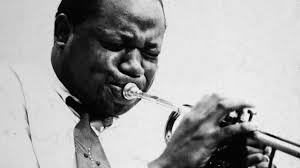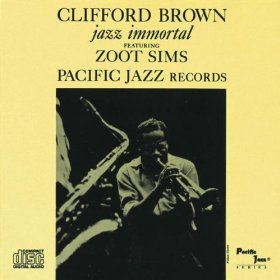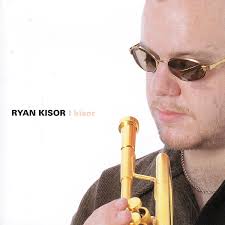Daahoud – Clifford Brown
Lead sheets plus Clifford Brown's Transcribed Trumpet Solo from his septet recording, and his Master and Alternate Solos from the quintet recording. Solos in B-flat and C editions. Also check out trumpeter Ryan Kisor's version, with Willie Jones III's transcribed drumming.
- Recording: Clifford Brown featuring Zoot Sims - Jazz Immortal
- Recorded on: July 12, 1954
- Label: Capitol (CDP 7 46850 2)
- Concert Key: E-flat
- Vocal Range: , to
- Style: Swing (uptempo)
- Trumpet - Clifford Brown
- Valve Trombone - Stu Williamson
- Tenor Sax - Zoot Sims
- Baritone Sax - Bob Gordon
- Piano - Russ Freeman
- Bass - Joe Mondragon
- Drums - Shelly Manne
- Description
- Historical Notes
- Solos
- Piano Corner
- Bass Corner
- Drum Corner
- Guitar Corner
- Inside & Beyond
- Minus You
Two details of this song are often overlooked. The pickups into the first and fifth measures of the B section are frequently played wrong: the first two notes of the pickup are often D and E♭ for the first one, and C and D♭ for the second. As the lead sheet shows, this is incorrect; these pairs of notes are both actually a whole step higher. The other frequent mistake in this song concerns the seventh measure of C, before the interlude. Often, the last note of the sixth measure, the D, is held over into the seventh measure. However, on the original recording it is short, and the seventh measure is a drum break. Though all this is indicated in the updated Hal Leonard Real Book, the lead sheet in the book does not contain any rhythm section figures or breaks, or a separate set of solo changes.
It should also be noted that the set of hits often played in the first measure of the A section, on the "and" of beat 1, beat 3, and the "and" of beat 4, does not appear on this classic recording. (The Jeremy Pelt and Oscar Peterson versions in the videos above have these hits.) A related set of hits, with the first one on beat 2 instead of the "and" of 1, occurs in the septet arrangement on Clifford's Pacific Jazz recording.
The print arrangements for both quintet and septet are available on musicdispatch.com. Clifford Brown's trumpet solos are available here from jazzleadsheets.com (click the Solos tab for description and audio clip).
As you'll hear in our teaser septet arrangement audio clip, arranger Jack Montrose created a very interesting, unique environment for the melody, starting right off with a modulating introduction.
The septet and quintet arrangements are both classics, and the printed arrangements are available from Second Floor Music. They're accurate and complete. Arranger Jack Montrose gave us a copy of his score for the septet recording session.
Purchase the Daahoud arrangements online from Music Dispatch:
Related Songs
Email Send Daahoud to a friend
- Recording: Clifford Brown and Max Roach - Clifford Brown And Max Roach
- Recorded on: August 6, 1954
- Label: EmArcy (MG 36036)
- Concert Key: E-flat
- Vocal Range: , to
- Style: Swing (uptempo)
- Trumpet - Clifford Brown
- Tenor Sax - Harold Land
- Piano - Richie Powell
- Bass - George Morrow
- Drums - Max Roach
- Description
- Historical Notes
- Solos
- Piano Corner
- Bass Corner
- Drum Corner
- Guitar Corner
- Inside & Beyond
- Minus You
In particular, our editions show all the rhythm section hits and breaks in the head, including several hits on the bridge that fit with the melody but are not commonly played. The interlude that sets up the solo sections looks strange without hits and rests for the rhythm section.
Two details of this song are often overlooked. The pickups into the first and fifth measures of the B section are frequently played wrong: the first two notes of the pickup are often D and E♭ for the first one, and C and D♭ for the second. As the lead sheet shows, this is incorrect; these pairs of notes are both actually a whole step higher. The other frequent mistake in this song concerns the seventh measure of C, before the interlude. Often, the last note of the sixth measure, the D, is held over into the seventh measure. However, on the original recording it is short, and the seventh measure is a drum break. Though all this is indicated in the updated Hal Leonard Real Book, the lead sheet in the book does not contain any rhythm section figures or breaks, or a separate set of solo changes.
It should also be noted that the set of hits often played in the first measure of the A section, on the "and" of beat 1, beat 3, and the "and" of beat 4, does not appear on this classic recording. (The Jeremy Pelt and Oscar Peterson versions in the videos above have these hits.) A related set of hits, with the first one on beat 2 instead of the "and" of 1, occurs in the septet arrangement on Clifford's Pacific Jazz recording (see the first album cover).
The print arrangements for both quintet and septet are available at musicdispatch.com. Clifford Brown's trumpet solos are available here from jazzleadsheets.com (click the Solos tab for description and audio clip).
Clifford Brown's composition Daahoud is a true jazz standard, having been recorded by many different artists over the past 50-plus years. The recordings of Clifford Brown playing it are also classics. His first three recorded takes of Daahoud were done on two quite different sessions. First, Clifford recorded Daahoud on a septet session on July 12, 1954, for Pacific Jazz, with arrangements by Jack Montrose. For details, click the album cover on the left. Then, less than a month later, the Clifford Brown - Max Roach Quintet recorded two takes of Daahoud at the end of their August 6, 1954, session.
Don Sickler: "The septet and quintet arrangements are both classics, and the printed arrangements are available from Second Floor Music. They're accurate and complete. Years ago, arranger Jack Montrose gave me a copy of his score for the septet recording session. The quintet arrangement is complete with all the nuances in the rhythm section parts."
Purchase the Daahoud Quintet arrangement online from Music Dispatch.
Related Songs
Email Send Daahoud to a friend
- Recording: Ryan Kisor - Kisor
- Recorded on: January 26, 2000
- Label: Video Arts Music (VACZ 1149)
- Concert Key: E-flat
- Vocal Range: , to
- Style: Swing (medium up)
- Trumpet - Ryan Kisor
- Piano - Peter Zak
- Bass - John Webber
- Drums - Willie Jones III
Purchase Daahoud - Clifford Brown
Purchasing this song through our affiliate links with certain retailers provides jazzleadsheets.com with additional support to help keep us bringing you the best lead sheets available. Thank you!
Video
- Description
- Historical Notes
- Solos
- Piano Corner
- Bass Corner
- Drum Corner
- Guitar Corner
- Inside & Beyond
- Minus You
-- everything Jones plays on the in and out melodies
-- horn melodies written above the drum staff
-- comping and time for first eight bars of Ryan Kisor's trumpet solo
-- two choruses of trading eights, including sticking patterns CLIP
Daahoud has been interpreted by many great drummers, including Shelly Manne and Max Roach. Willie Jones III's approach is another, and it's definitely worth checking out. Despite the song's strong melody, Willie's musical intuition and his use of quick and smooth phrasing allows him to fill in and complement any gap in the melody. Included in our drum transcription are sticking patterns and accents throughout the solo sections, which highlight Willie Jones III's attention to detail and sound. His approach to playing this song is rather different than that of Max Roach who breaks his ride cymbal groove during the melody to play most of the melodic figures on his drums. You can see Willie playing Daahoud live in Amsterdan here.
Check out our Drum Corner for more transcriptions by Willie Jones III and other masters.
Related Songs
Email Send Daahoud to a friend

Clifford Brown
October 30, 1930 – June 27, 1956
Clifford Brown was a legendary and influential trumpet player who had everything going for him: an incredible sound, dazzling technique and ideas, and a great compositional gift. Brown was in the limelight for just five years (he died in a car accident at age 25) yet his mark on jazz is indelible. Early performances at jam sessions with Dizzy Gillespie, Charlie Parker and Fats Navarro (his major influences) led to work with R&B bandleader Chris Powell, which included his first commercial recording (March 21, 1952). His second commercial recording was with Lou Donaldson for Blue Note Records (June 9, 1953), a session that also included Philly Joe Jones and Elmo Hope (Carvin' The Rock, De-Dah and Bellarosa). On this session, Clifford also got to record one of his own compositions (Brownie Speaks), which became his first recorded composition. Read more...





